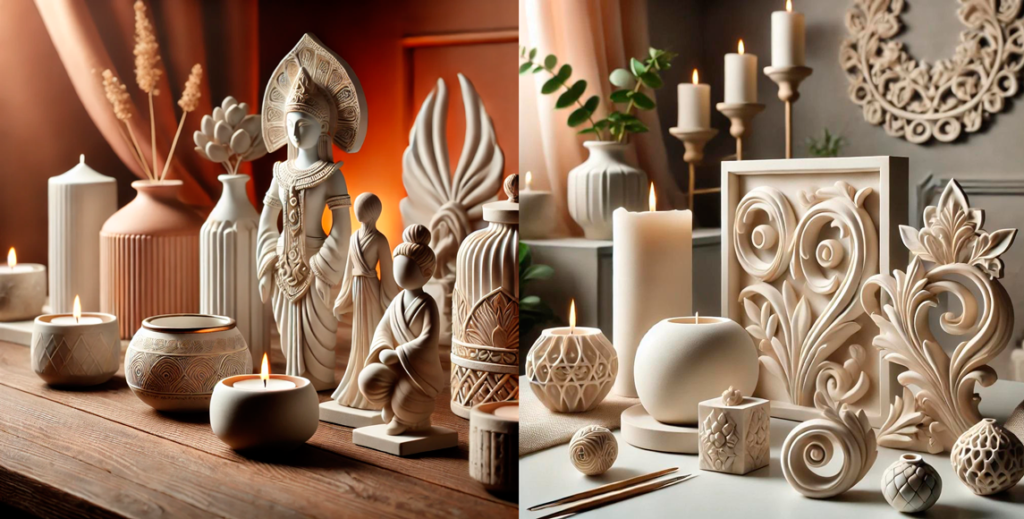✅ Are you planning to sell polymer plaster decorative products or soy candle containers? Find out what standards you need to meet and what documents and tests are required to legally and safely market your products!
1. Required documentation - what do you need to have?
In order to legally sell products with polymeric gypsum, it is necessary to have the appropriate documentation. Here are the most important documents that are required or recommended:
📌 Safety Data Sheet (SDS)
➡ Available from suppliers of polymer gypsum and additives.
➡ Describes chemical composition, properties and possible hazards.
➡ Required if the product contains chemicals that may be hazardous to health.
📌 CE Declaration of Conformity (if required)
➡ Necessaryif the product is subject to safety standards, e.g. EN 71-3 (for products that may come into contact with children).
➡ Optional for decorative plaster casts, but recommended for utility products.
📌 Technical product specification
A technical specification is a document containing key information about a product, its properties and its use. It should include:
✔ Product name - unambiguous identification of the product.
✔ Composition - main raw materials and possible additives.
✔ Physical and chemical properties - e.g. hardness, temperature resistance, moisture absorption.
✔ Application - what the product is intended for, how it should be used.
✔ Storage conditions - optimum environment, e.g. protection from moisture or temperature.
✔ Warnings and precautions - information on possible risks and safe use.
This document is essential for both customers and inspection authorities, confirming the quality and safety of the product.
📌 Label compliant
Every product for sale must be correctly labelled.
➡ What should the label contain?
✔ Product name
✔ Manufacturer/distributor information
✔ Warnings (e.g. dustiness, fragility, contact with heat)
✔ Recycling labels and instructions for use
📌 Is research required?
Not always, but in the case of products in contact with heat, skin or foodstuffs, research is necessary.
2 What standards must decorative polymer gypsum products meet?
Polymer gypsum decorative products may be subject to specific standards depending on their application.
✅ EN 71-3: Safety of toys - Migration of certain elements
➡ Required if the product may come into contact with children, e.g. decoration for children's rooms.
➡ Reduces heavy metals and other substances that may be released from the material.
✅ EN 12572: Gypsum products - Requirements for materials and durability
➡ Determines resistance to moisture, abrasion and cracking - essential for durable decorative elements.
✅ EN 15284: Synthetic gypsum - Technical requirements
➡ Includes requirements for chemical composition, mechanical strength and reaction to fire.
✅ EN 13501-1: Fire classification of construction products
➡ If the decorations are intended for indoor use in public areas, they may require testing for reaction to fire.
✅ EN 15824: Specification for gypsum-based plasters and decorative products
➡ For wall-mounted products.
3 Frequently Asked Questions (FAQ)
Can polymer gypsum products come into contact with food?
Not all polymer gypsum products are suitable for food contact. In order for the product to be used as e.g. bowls, plates, cups or food holders, must comply with the relevant standards and regulations:
➡ Regulation (EC) No 1935/2004 - concerns materials and articles intended to come into contact with foodstuffs.
➡ Standard EN 1186 - sets out tests for migration of chemicals into food.
➡ Standard EN 13130 - concerns the analysis of chemical substances released from materials.
📌 If the product is not certified for food contact, it should be labelled as 'not for food contact'.
📌 Alternatively, safe coatings and varnishes certified for food contact can be used.
Is a safety data sheet (SDS) for the dye sufficient?
Not just a dye, but any component of the mixture from which the product is made, or protective coating is treated as a raw material.
➡ For each raw material, you must have an SDS card if it requires one.
➡ If the dye contains hazardous substances, SDS is mandatory.
➡ This also applies to resins, hardeners and other chemical additives.
➡ It is worth checking compliance with the REACH regulation (EC 1907/2006).
📌 If the product comes into contact with children or the skin, it is worth checking its compatibility with EN 71-3.
Are tests done at home sufficient for candle containers and decorative items?
Home tests can be helpful, but are not sufficient to fully comply with the standards.
🔹 Containers for candles must meet EN 15493 - temperature resistance can be tested at home (~90°C), but laboratory tests are more reliable.
🔹 Decorative elements should be resistant to moisture and damage - this can be tested at home, but laboratory tests provide full certification.
📌 It is worth contacting laboratories that perform tests on ceramics, glass and composites.
Does the acrylic varnish or impregnation with which we protect products require SDS or other documentation?
Yes, if the varnish, impregnation or other protective coating used is a chemical substance, it may require an SDS (material safety data sheet).
➡ Mandatory SDS - if the paint or varnish contains substances classified as hazardous to health or the environment.
➡ Requirements under REACH (EC 1907/2006) - regulation on the use of chemicals in the EU.
➡ Additional certificates - if the product comes into contact with food or the skin, it is worth checking its hygiene certificate.
📌 If the waterproofing is based on natural ingredients and the manufacturer does not classify it as hazardous, SDS may not be required.
📌 For complete certainty, it is worth asking the supplier for documentation, such as safety certificates and compliance tests.





